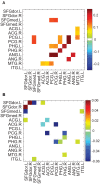Habitual tea drinking modulates brain efficiency: evidence from brain connectivity evaluation
- PMID: 31209186
- PMCID: PMC6594801
- DOI: 10.18632/aging.102023
Habitual tea drinking modulates brain efficiency: evidence from brain connectivity evaluation
Abstract
The majority of tea studies have relied on neuropsychological measures, and much fewer on neuroimaging measures, especially for interregional connections. To date, there has been no exploration of the effect of tea on system-level brain networks. We recruited healthy older participants to two groups according to their history of tea drinking frequency and investigated both functional and structural networks to reveal the role of tea drinking on brain organization. The results showed that tea drinking gave rise to the more efficient structural organization, but had no significant beneficial effect on the global functional organization. The suppression of hemispheric asymmetry in the structural connectivity network was observed as a result of tea drinking. We did not observe any significant effects of tea drinking on the hemispheric asymmetry of the functional connectivity network. In addition, functional connectivity strength within the default mode network (DMN) was greater for the tea-drinking group, and coexistence of increasing and decreasing connective strengths was observed in the structural connectivity of the DMN. Our study offers the first evidence of the positive contribution of tea drinking to brain structure and suggests a protective effect on age-related decline in brain organisation.
Keywords: DTI; brain efficiency; default mode network; fMRI; hemispheric asymmetry; tea drinking.
Conflict of interest statement
Figures





Similar articles
-
A Longitudinal Study of Changes in Resting-State Functional Magnetic Resonance Imaging Functional Connectivity Networks During Healthy Aging.Brain Connect. 2020 Sep;10(7):377-384. doi: 10.1089/brain.2019.0724. Epub 2020 Aug 19. Brain Connect. 2020. PMID: 32623915 Free PMC article.
-
Preterm birth leads to impaired rich-club organization and fronto-paralimbic/limbic structural connectivity in newborns.Neuroimage. 2021 Jan 15;225:117440. doi: 10.1016/j.neuroimage.2020.117440. Epub 2020 Oct 8. Neuroimage. 2021. PMID: 33039621
-
The Longitudinal Trajectory of Default Mode Network Connectivity in Healthy Older Adults Varies As a Function of Age and Is Associated with Changes in Episodic Memory and Processing Speed.J Neurosci. 2018 Mar 14;38(11):2809-2817. doi: 10.1523/JNEUROSCI.3067-17.2018. Epub 2018 Feb 13. J Neurosci. 2018. PMID: 29440553 Free PMC article.
-
Non-classical behavior of the default mode network regions during an information processing task.Brain Struct Funct. 2020 Nov;225(8):2553-2562. doi: 10.1007/s00429-020-02143-1. Epub 2020 Sep 16. Brain Struct Funct. 2020. PMID: 32939584
-
The structural and functional connectivity of the posterior cingulate cortex: comparison between deterministic and probabilistic tractography for the investigation of structure-function relationships.Neuroimage. 2014 Nov 15;102 Pt 1:118-27. doi: 10.1016/j.neuroimage.2013.12.022. Epub 2013 Dec 21. Neuroimage. 2014. PMID: 24365673 Review.
Cited by
-
Polyphenolic compounds as electron shuttles for sustainable energy utilization.Biotechnol Biofuels. 2019 Nov 18;12:271. doi: 10.1186/s13068-019-1602-9. eCollection 2019. Biotechnol Biofuels. 2019. PMID: 31832094 Free PMC article. Review.
-
Study protocol: The efficacy of mushroom to prevent cognitive decline in at-risk middle-aged adults and young-olds living in the community.Front Aging Neurosci. 2025 Jun 9;17:1588493. doi: 10.3389/fnagi.2025.1588493. eCollection 2025. Front Aging Neurosci. 2025. PMID: 40552321 Free PMC article.
-
Cohort profile: the Diet and Healthy Aging (DaHA) study in Singapore.Aging (Albany NY). 2020 Nov 18;12(23):23889-23899. doi: 10.18632/aging.104051. Epub 2020 Nov 18. Aging (Albany NY). 2020. PMID: 33271510 Free PMC article.
-
Impact of MASP2 gene polymorphism and gene-tea drinking interaction on susceptibility to tuberculosis.Sci Rep. 2021 Mar 22;11(1):6544. doi: 10.1038/s41598-021-86129-x. Sci Rep. 2021. PMID: 33753877 Free PMC article.
-
Combinations of Tibetan tea and medicine food homology herbs: A new strategy for obesity prevention.Food Sci Nutr. 2022 Sep 28;11(1):504-515. doi: 10.1002/fsn3.3081. eCollection 2023 Jan. Food Sci Nutr. 2022. PMID: 36655078 Free PMC article.
References
-
- Hoffmann F, Manning M. Herbal Medicine and Botanical Medical Fads. 1st ed. New York: Haworth Press; 2002. 202 pp.
Publication types
MeSH terms
Substances
LinkOut - more resources
Full Text Sources

